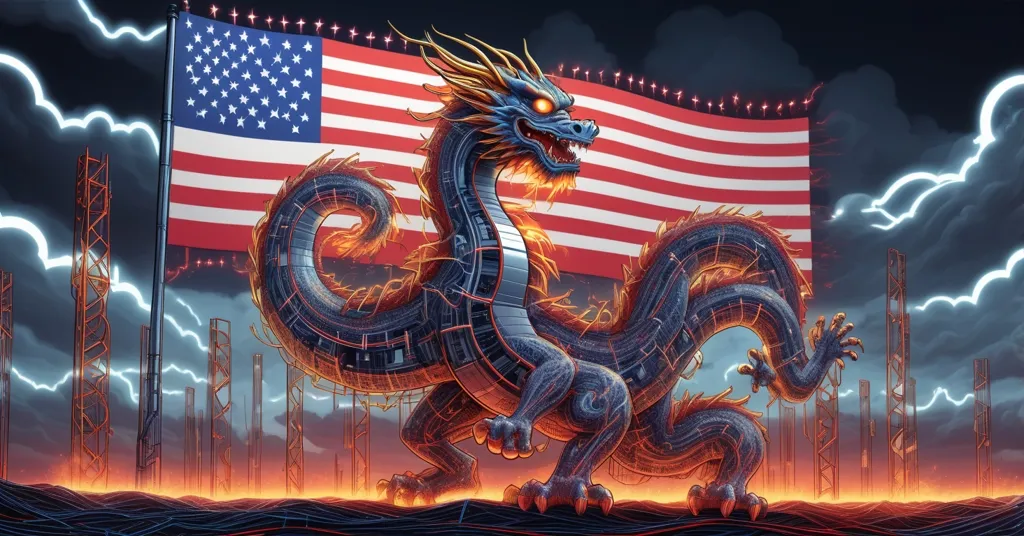US Bitcoin Mining Hits Record 31.5% Hash Rate as Chinese ASIC Firms Evade Tariffs

US Bitcoin Mining Surge in 2025: Chinese ASIC Giants Dodge Tariffs Amid Rising Tensions
Bitcoin mining in the United States has hit a historic peak in mid-2025, with American operators commanding a staggering 31.5% of the global BTC network hash rate. Yet, behind this milestone lurks a brutal mix of skyrocketing costs, geopolitical chess games, and environmental heat that could redefine the industry’s future.
- US Hash Rate Dominance: U.S.-listed miners hold 31.5% of global BTC hash rate, with total share likely over 40%.
- Profitability Crunch: Mining costs near $100,000 per BTC as transaction fees tank below 1% of rewards.
- Geopolitical Moves: Chinese ASIC makers set up U.S. bases to evade Trump’s tariffs, sparking security debates.
US Mining Powerhouse: Triumphs and Troubles
The United States is flexing serious muscle in the Bitcoin mining arena. According to JPMorgan, 13 publicly listed mining giants like CleanSpark, Hive Technologies, and Riot Platforms are driving a record 31.5% share of the global Bitcoin network hash rate—the computational power securing the blockchain. When factoring in private operators, some estimates push the total U.S. share past 40%, a high watermark fueled by crypto-friendly policies under Donald Trump’s second term, which kicked off in January 2025. For those new to the game, hash rate is the total processing power miners dedicate to solving complex math problems to validate Bitcoin transactions and earn rewards. A higher hash rate means a more secure network but also fiercer competition, as detailed in this comprehensive Bitcoin overview.
Before we get too excited, let’s slap some cold reality on this hot streak. Mining a single Bitcoin now costs just under $100,000, toe-to-toe with its market price, according to industry data. This isn’t pocket change—it’s a brutal margin squeeze driven by network hash rates hovering around 890-900 exahashes per second (EH/s), near all-time highs. Think of this as a tech arms race where miners must constantly upgrade their gear—specialized hardware called ASICs (Application-Specific Integrated Circuits)—just to stay in the game. Add to that electricity costs, which vary wildly (cheaper in Texas at around 3-5 cents per kWh versus 15+ cents in parts of New York), and you’ve got a recipe for financial cardio. As per recent analyses on Bitcoin mining profitability challenges, mining’s energy appetite isn’t getting any smaller, making location and power deals critical.
Then there’s the gut punch of shrinking revenue. Transaction fees—small payments users make to miners for processing Bitcoin transfers on the blockchain—have plummeted to less than 1% of total block rewards, the lowest since January 2022. Block rewards, for the unversed, are newly minted Bitcoins miners get for each block they solve, but these rewards got slashed during the 2024 Bitcoin halving, an event that cuts issuance roughly every four years to control supply. With most transactions now happening off-chain—think trades on centralized exchanges like Coinbase or Binance—miners miss out on those fees entirely. It’s like running a toll booth on a road nobody uses. Canaan Inc’s VP Zhibing ‘Tony’ Li put it sharply:
“Miners need to evolve beyond the traditional hash-per-dollar model. As block rewards decline and difficulty rises, mining will face a structural shift. Transaction fees will take center stage, replacing block subsidies as the primary revenue stream.”
The hash price, a metric of daily revenue per unit of computational power, has also dipped 2% since May 2025, per JPMorgan, signaling that even U.S. dominance can’t shield miners from a profitability crisis. Are we witnessing a golden era or just fool’s gold? For more on this trend, check out the JPMorgan report on U.S. hash rate growth.
Geopolitical Game: Chinese ASICs on US Soil
While U.S. miners battle economics, the hardware supply chain is turning into a geopolitical battlefield. Over 90% of the world’s Bitcoin mining rigs come from Chinese manufacturers like Bitmain, Canaan, and MicroBT. Facing Trump’s sledgehammer tariffs—a baseline 10% on imports plus an extra 20% for Chinese goods—these giants are making a bold play: setting up shop in the U.S. Bitmain started production stateside in December 2024, Canaan launched a trial operation in April 2025, and MicroBT is crafting a “localization strategy” to dodge the trade war fallout. This isn’t just about saving a few bucks; it’s a survival move when tariffs threaten to choke off access to the rigs miners desperately need, as explored in this report on Chinese ASIC makers relocating to the U.S..
But don’t expect a red carpet rollout. U.S.-based ASIC maker Auradine, backed by mining heavyweight MARA, is waving a national security red flag. They’re lobbying hard for tighter regulations on Chinese firms and pushing for tax credits or subsidies to boost domestic manufacturers. Their argument isn’t baseless. Crypto-law attorney John Deaton calls China’s hardware grip a “choke point” for U.S. miners—if Beijing slapped an export ban tomorrow, operations could grind to a halt, tanking hash rates and rattling Bitcoin’s network stability. Auradine’s policy stance is blunt, and further discussion on these tariff-related challenges for miners can be found in online communities. Auradine stated:
“Expediently reduce miners’ reliance on Chinese vendors to ensure economic security.”
Canaan’s business development VP Leo Wang fired back with a no-nonsense quip:
“Mining rigs are useless if not applied to Bitcoin mining.”
In other words, these machines are built for one job—mining Bitcoin—not spying or sabotage. Still, with trade tensions simmering and additional U.S. threats targeting Chinese assembly plants in Southeast Asia, the risk of supply chain weaponization looms large. Insights into how Trump’s tariffs impact Chinese firms shed light on the broader implications. What if a full-blown trade escalation cuts U.S. miners off for months? Bitcoin’s decentralized ethos could take a serious hit if hash power consolidates under vulnerable supply lines. It’s 4D chess, and U.S. miners might be stuck playing checkers. For a deeper look at potential security risks with Chinese hardware in U.S. mining, the debate continues to evolve.
Global Roadblocks: Policy Chaos Worldwide
Zooming out, Bitcoin mining’s challenges aren’t just a U.S. problem—global policies are throwing curveballs everywhere. In France, a proposal to launch state-run Bitcoin mining, potentially fueled by surplus nuclear energy, got shot down by the National Assembly on procedural grounds. It’s a missed shot at using clean power to mine BTC, especially when nuclear could slash carbon footprints by significant margins—some studies suggest up to 90% less emissions compared to coal-based grids. Could this rejection deter similar ideas in the U.S., or might it inspire private-public partnerships instead?
Meanwhile, Russia’s mining scene is a regulatory dumpster fire. Only 30% of miners have registered with a mandatory gear registry, per the Federal Tax Service, leaving Deputy Finance Minister Ivan Chebeskov to grumble that two-thirds of the sector needs to be “cleaned up.” Fines up to $25,500 for non-compliant companies are on the table, and illegal operations—like those busted in Buryatia—keep popping up. This mess isn’t just a local headache; it distorts global hash rate distribution and raises questions about how much “hidden” mining power could destabilize the network if uncovered or shut down. Compared to Trump’s deregulation push—easing energy restrictions for U.S. miners—these fragmented rules worldwide highlight a stark contrast. But here’s a devil’s advocate twist: does making the U.S. a hash rate hub with over 40% share risk turning Bitcoin into a political football for the next administration? Over-centralization, even in a decentralized system, isn’t just a tech issue—it’s geography.
Energy Ethics: Bitcoin and AI in the Hot Seat
Bitcoin mining’s infamous energy hunger is getting outshined by another tech beast: artificial intelligence. AI large language models are projected to devour 49% of global data center power by the end of 2025, dwarfing mining’s slice of the pie (estimated at around 150 TWh annually by Cambridge). But both sectors are under the same environmental microscope. Take Elon Musk’s xAI and its “Colossus” data center in Memphis, Tennessee. Since June 2024, it’s been running unauthorized methane gas turbines, emitting pollutants like nitrogen oxides, per the Southern Environmental Law Center (SELC). With thermal imagery showing turbine upgrades to larger units, SELC and the NAACP are prepping a lawsuit over Clean Air Act violations, spotlighting harm to predominantly Black communities like Boxtown, where cancer risks are already four times the national average. Musk, who once nixed Tesla’s Bitcoin payments over eco-concerns, now faces his own green hypocrisy. For more on this, see the lawsuit details regarding xAI’s environmental impact. Talk about a plot twist.
This isn’t just an AI scandal—it’s a wake-up call for Bitcoin miners. Energy scrutiny is relentless, but some are fighting back with innovation. Miners in Canada tap hydropower, while others in Texas harness flared gas from oil fields, cutting emissions by repurposing waste. Big Tech offers inspiration too: Amazon, Google, and Meta are signing nuclear power deals to fuel AI ops. Why aren’t more miners jumping on this sustainable bandwagon? If Bitcoin wants to stay the gold standard of decentralized money, it can’t afford to ignore the ethics of power. Rushing hash rate dominance is badass, but building on quicksand—environmentally or otherwise—could sink us all.
Financial Fumbles: Investor Skepticism Grows
Back to the money grind, U.S. miner Bitdeer’s recent bid to raise $330 million (potentially $363 million) in convertible debt for data center expansion and ASIC development got a frosty reception. Shares cratered over 7% to $11.80, even as the market cap for U.S.-listed miners bumped 10% to $2.4 billion in early June 2025, per JPMorgan. What gives? Investors seem to be sniffing out a disconnect between hype and reality—mining a Bitcoin for $100,000 isn’t exactly a get-rich-quick gig. And let’s not sugarcoat it: beware of shady firms or stock pumpers promising moonshot profits or dirt-cheap rigs. Mining’s a slog, not a lottery ticket. This skepticism flags a bigger question—are we over-leveraging a future that can’t sustain itself?
Bitcoin’s 2025 Survival Test: Key Takeaways and Questions
Let’s break down the critical points and questions shaping Bitcoin mining’s wild ride in 2025, with clear answers to ground us in this high-stakes, decentralized frontier:
- How dominant are U.S. miners in the global Bitcoin network?
They’ve hit a record 31.5% hash rate share among listed firms, with estimates over 40% total, propelled by Trump’s crypto-friendly deregulation since January 2025. - Why are profits evaporating despite this growth?
Costs to mine one BTC are nearing $100,000, transaction fees are a measly 1% of rewards, and hash rates near 900 EH/s keep the competition cutthroat. - What’s pushing Chinese ASIC makers to the U.S.?
Trump’s tariffs—10% baseline plus 20% on Chinese goods—force giants like Bitmain (since Dec 2024) and Canaan (trial since April 2025) to localize production and skirt import taxes. - Are national security fears over Chinese hardware valid?
Yes—U.S. firms like Auradine warn a supply cutoff from China could cripple miners, risking network stability, a concern backed by legal experts like John Deaton. - How do global policies impact Bitcoin mining?
France’s rejection of state mining wastes clean nuclear potential, Russia’s 30% compliance rate breeds illegal ops, while U.S. deregulation boosts growth but risks centralization. - What’s the environmental overlap between Bitcoin and AI?
AI’s 49% data center power grab by late 2025 and xAI’s Memphis pollution mess echo mining’s energy critiques, demanding sustainable solutions like hydro or nuclear. - Why are investors wary of miners like Bitdeer?
A 7% share drop after a $330 million debt raise signals doubt in mining profitability, despite a $2.4 billion market cap spike, hinting at overhyped optimism.
Bitcoin mining in 2025 is a pressure cooker of epic wins and epic fails. U.S. dominance is undeniable, but $100,000 production costs and dwindling fees make it a brutal grind. Chinese ASIC giants are adapting to Trump’s trade war with U.S. roots, yet security risks linger like a dark cloud. Globally, policy chaos and environmental backlash—hitting both Bitcoin and AI—demand urgent pivots to clean energy or new revenue streams. Even as a Bitcoin maximalist, I’ll tip my hat to altcoins like Ethereum, whose post-merge energy cuts show ideas worth watching, though BTC remains the king of decentralization. This isn’t just tech—it’s a clash of economics, politics, and ethics on the blockchain. Let’s keep pushing for a future that disrupts the status quo without screwing us over. Effective accelerationism means speed, sure, but not at the cost of stability. So, is this U.S. mining boom a foundation or a mirage? Keep digging for answers in this raw, untamed space.



